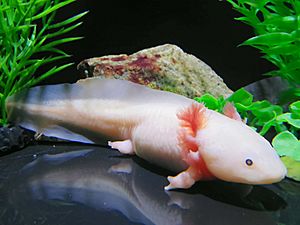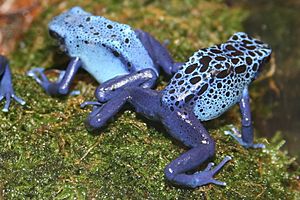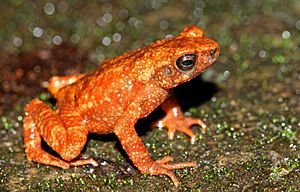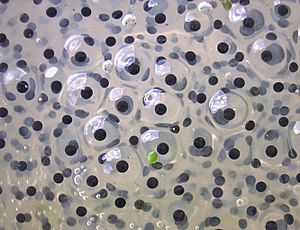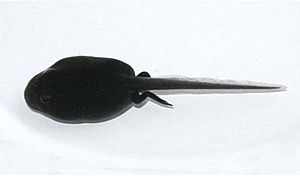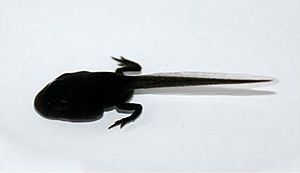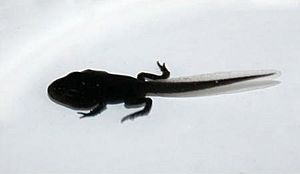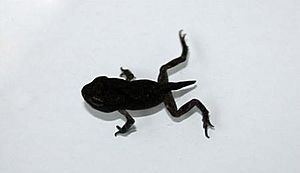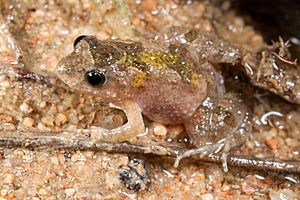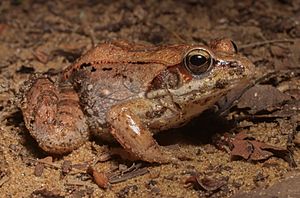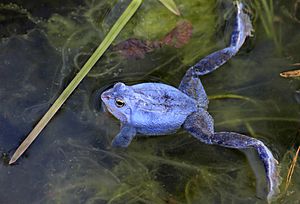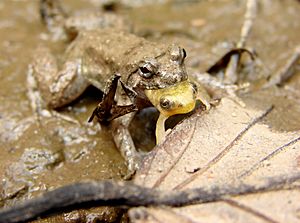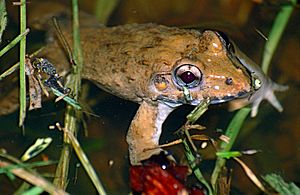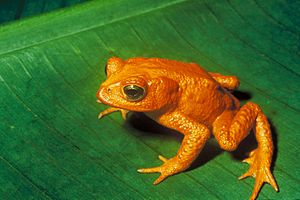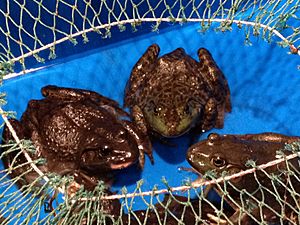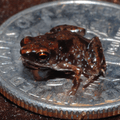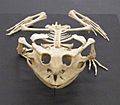Amphibian facts for kids
Quick facts for kids AmphibianTemporal range: late Devonian – Recent
|
|
|---|---|
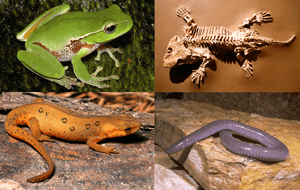 |
|
| Frogs (top left), Seymouria (fossil) (top right), salamanders and newts (bottom left) and caecilians (bottom right) are all amphibians. |
|
| Scientific classification | |
| Kingdom: | |
| Phylum: | |
| Subphylum: | |
| Class: |
Amphibia
|
Amphibians are amazing animals that can live both on land and in water! Their name "amphibian" comes from two Greek words: "amphi" meaning "both" and "bio" meaning "life". This perfectly describes their dual lifestyle. Amphibians belong to the animal group called the class Amphibia.
Today, the main types of amphibians you can find are frogs (which include toads), salamanders (including newts), and caecilians. These creatures are four-legged vertebrates, meaning they have a backbone. They are also cold-blooded, which means their body temperature changes with their surroundings.
Amphibians usually lay their eggs in water, often in a foamy nest. When the eggs hatch, tiny creatures called tadpoles emerge. Tadpoles live in water and breathe using gills, just like fish. As they grow, tadpoles go through a big change called metamorphosis. They transform into adults, growing lungs to breathe air and legs to move on land. Adult amphibians can also breathe through their skin, especially when it is moist. Some types of salamanders don't even have lungs and rely only on their skin for breathing!
The very first amphibians appeared a long, long time ago, during the Devonian period. They evolved from lobe-finned fish that had strong, leg-like fins with digits, which helped them crawl along the bottom of the sea. Some of these early fish even developed simple lungs to help them breathe air when the water in swamps had low oxygen. Their strong fins also allowed them to pull themselves out of the water and onto dry land if they needed to.
For a long time, during the Carboniferous and early Permian periods, amphibians were the top predators on land, especially in warm, wet river areas. But as the climate became drier, they struggled more. Animals that laid cleidoic eggs (eggs with hard shells that could be laid out of water), like the ancestors of mammals and reptiles, started to take over the land. Most of the large, early amphibians became extinct during the Triassic period. However, some amphibians, like the common coquí frog, lay their eggs out of water, and their young develop directly into adult frogs without a tadpole stage.
Today, all living amphibians belong to a group called Lissamphibia. This group includes the Anura (frogs and toads), Caudata (salamanders and newts), and Gymnophiona (caecilians). Compared to mammals or reptiles, modern amphibians are generally quite small. The smallest frog and vertebrate in the world is the New Guinea frog (Paedophryne amauensis). The largest amphibian is the Chinese Giant Salamander (Andrias davidianus).
Amphibians live all over the world, except in Antarctica. They need moist or watery places to reproduce, which limits where they can live. There are about 5,565 different species of amphibians known today. A huge 88% of them are frogs and toads!
Amphibians have more species than mammals, even though they live in fewer types of places. Sadly, amphibian populations are decreasing worldwide. Protecting them is a very important task for scientists and conservationists.
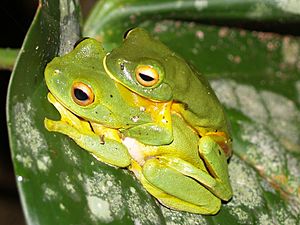
Contents
What are Amphibians Like?
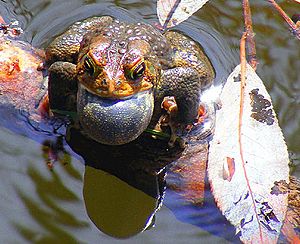
Amphibians often like to live near freshwater when the weather is warm. However, some species can be found in forests, deserts, and even cold arctic areas. Adult amphibians use their lungs to breathe, but they also take in oxygen through their skin, as long as it stays moist.
Many amphibians use camouflage to blend in with their surroundings. They might be brown or green, helping them hide from predators like birds and reptiles. Their color is their main way to stay safe.
On the other hand, many other amphibians have toxic skin. This means their skin is harmful to predators if eaten. This is a very important defense. These amphibians often have bright, warning colors like red, black, and yellow to tell predators to stay away.
Scientists have studied the Rough-skinned newt and the Garter snake to see how they have co-evolved. In places where they live together, the newts become more poisonous, and the snakes develop more resistance to the poison.
Amphibians have color vision and can focus their eyes clearly. They also have eyelids, glands, and ducts that keep their eyes moist. These features are adaptations that helped them live on land. Amphibians were the first vertebrates to have these special eye features.
Types of Amphibians
Frogs and Toads (Anura)
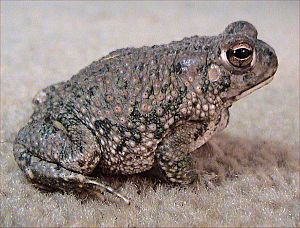
The order Anura includes all frogs and toads. There isn't a big scientific difference between them.
Frogs usually have a short body, webbed feet, eyes that stick out, a forked tongue, and no tail. They are amazing jumpers! Many of their body parts, especially their long, strong legs, are perfect for jumping. Frogs often live near water or in humid places.
People often tell frogs and toads apart by how they look. Toads often have bumpy, warty skin, which helps them produce toxic slime. Their skin is also usually drier, which helps them live in drier places. These features have developed many times independently in different species, which is called convergent evolution.
Salamanders and Newts (Caudata)
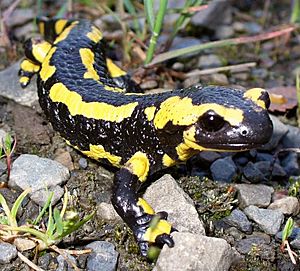
The order Caudata includes all salamanders.
Newts are a type of salamander that spend most of their adult lives in water. They belong to a specific subfamily called Pleurodelinae. The California newt can even survive a fire by covering its body with mucus!
How salamanders breathe (called respiration) is different for various species. Some species don't have lungs and breathe through gills. Often, these are external gills that look like feathery tufts on the sides of their heads. Many species, like the Olm, have both lungs and gills as adults. Some salamanders that live on land don't have lungs or gills at all; they breathe only through their skin! Even those with lungs often use their skin to help them breathe.
Salamander skin produces mucus. This mucus helps keep them moist on land, balances their salt levels in water, and helps them swim smoothly.
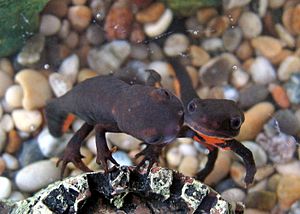
Axolotls, which are a type of mole salamander (genus Ambystoma), are special because they are neotenic. This means they can become adults and reproduce while still looking like larvae.
Most salamanders and newts have ways to defence against predators. They often have a poison that makes them taste bad to predators. Their bright colors are a warning sign. If a salamander is camouflaged, it probably doesn't have a strong poison.
Another defense is to drop their tail. The tail wiggles for a bit, distracting the predator while the salamander escapes. The tail can even grow back later!
Caecilians (Gymnophiona)
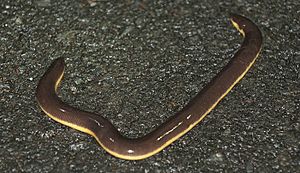
The order Gymnophiona includes the caecilians. These are long, thin, legless animals that look a lot like snakes or worms. Their skin has circular folds, making them look even more like earthworms.
Most caecilians are burrowing amphibians, meaning they dig into wet soil like worms. Some also live in water. Their heads are strong and have special bones that help them dig. Because caecilians have many vertebrae (bones in their backbone), they can bend their bodies very easily.
Caecilians are found in tropical parts of Africa, Asia, and Central and South America. There are 171 different species of caecilians.
How Amphibians Reproduce
Amphibians are the only vertebrates that go through metamorphosis, meaning their young look very different from their adults. Amphibians usually reproduce from early spring to late summer, though some breed in winter or fall.
Most frogs and toads, like the common frog (Rana temporalis), gather in large groups in ponds, rivers, swamps, and lakes to breed. Male frogs and toads often croak loudly to attract females.
A female frog can lay a huge number of eggs, from 100 to 60,000 in one clutch (group of eggs). These eggs are often called "frogspawn."
Amphibian reproduction is always connected to water in some way. This is because their eggs, even though they are covered in jelly, cannot survive for long in dry conditions.
Most female amphibians lay their eggs in water. The eggs can be laid one by one or in batches. Batches of eggs might look like a long chain or a ball of foam. Some amphibians wrap their eggs around plants in the water to keep them from drifting away.
Tree frogs often lay their eggs on a leaf over a rainwater pool. Some bullfrogs, like the male American bullfrog and the male African bullfrog, stay with their tadpoles and protect them from predators. They even use their noses to dig a channel to move their tadpoles to new places with more water, so the tadpoles don't dry out.
Most amphibians leave their eggs to take care of themselves. Fish and other animals eat many of these eggs. However, male midwife toads are special; they carry their eggs on their backs! When the eggs are ready to hatch, the toad goes back to the water and releases them.
Tadpole Life
When tadpoles hatch, they don't have lungs. Instead, they have gills. Gills have a large surface area, which helps tadpoles get a lot of oxygen from the water. Young tadpoles have their gills exposed on the outside of their bodies. As they get older, their gills become covered by skin.
When they first hatch, tadpoles eat all the time! Their first meal is usually what's left of their own eggs. Frog, toad, and newt tadpoles eat plants like algae and pondweed, or they filter feed tiny particles from the water. As they grow, they might start eating small animals in the water. Salamander tadpoles and surinam horned toad tadpoles are carnivorous (meat-eaters) throughout their tadpole stage.
The eggs of the spadefoot toad hatch very quickly, in just three days. Their tadpoles complete their metamorphosis in only six to eight days. This fast development happens because spadefoot toads lay their eggs in places where the water might dry up soon.
Tadpoles of frogs and toads first grow their back legs, then their front legs a few weeks later. When tadpoles grow their limbs, they are sometimes called "froglets" because they look like smaller versions of adult frogs and toads. Their tails continue to get shorter until they disappear completely.
Where Amphibians Live
Salamanders and newts can be found living in streams. Salamanders often hide in rotten logs, holes, or wet underground places like under leaves. Web-toed salamanders prefer habitats with many rocks, where they can hide under stones.
Tailed frogs like to live in cold water. In their habitats, amphibians generally prefer places with many hiding spots, such as small trees, logs, and plants nearby. Underwater, they like to hide near aquatic plants and rocks. Tree frogs and dart frogs often live in forests, on trees, plants, and on the ground under leaves.
Some amphibians can even be found in the desert or the arctic. The desert froglet lives in the desert. They are only active at night when temperatures are much cooler. Since it rarely rains in the desert, desert frogs will burrow underground to stay cool.
They use their mucus to keep themselves wet. This mucus hardens into a cocoon that keeps the water from escaping. Once in their cocoon, they stay still for several months or even years until a rainstorm.
The spadefoot toad will spit on the ground and then lie on it. Their bodies absorb the water. Their thin bodies with many blood vessels help them take in water through their skin.
Arctic frogs, like the wood frog, moor frog, and the common frog, must survive long periods of freezing temperatures. They burrow into places where they can form a cocoon. Like all living things, amphibians need water to survive, and they specifically need freshwater. Some burrowing frogs can store water in their bladders, which allows them to stay underground without drying out.
What Amphibians Eat
Amphibians are predatory animals. They mostly eat live invertebrates and animals that don't move too quickly. This includes caterpillars, earthworms, crayfish, water beetles, snails, and dragonfly larvae.
Many amphibians use their sticky tongues to catch their prey. They usually swallow the animal whole, but they might chew it a little to help it go down.
The Ranidae family and the Ceratophrys genus will eat almost anything they can fit into their mouths! This can include rodents, small birds, ducklings, small fish, and other small mammals.
Most frogs are cannibalistic, meaning they will eat each other if there is no other food. Some amphibians will even eat their own tadpoles and eggs if they can't find anything else to eat.
In captivity, pet frogs are often fed crickets, worms, small fish, rodents, and fruit flies.
Adult amphibians help to decrease the mosquito population by eating many of their larvae.
Protecting Amphibians
Amphibian populations are decreasing all over the world. Scientists say that this decline is one of the most critical threats to global biodiversity (the variety of life on Earth).
Many things are believed to be causing this decline. These include habitat destruction (when their homes are destroyed), over-exploitation (when too many are caught), pollution, new species being introduced to their habitats, climate change, damage to the ozone layer, and diseases like chytridiomycosis.
Ultraviolet radiation from the sun can also harm the skin, eyes, and eggs of amphibians.
How Humans Use Amphibians
Bullfrog legs are eaten as food in the Southern and Midwestern United States. In California, people need a special license to catch bullfrogs for food. People often hunt bullfrogs at night near rivers. The bullfrogs' legs are cooked, and their backs are often fried.
In China, bullfrogs are sold alive for eating. They are later cooked with vegetables. The emperor newt is also hunted in China for food and used in medicine.
In schools, bullfrogs are sometimes dissected in biology classes, usually in middle school or high school.
Amphibians are also kept as pets. They live in special tanks called aquariums (for water-dwelling ones) or terrariums (for land-dwelling ones).
See Also
 In Spanish: Anfibios para niños
In Spanish: Anfibios para niños
Images for kids
-
Many amphibians—like this Ceratophrys cranwelli—exhibit biofluorescence.
-
The world's smallest known vertebrate, Paedophryne amauensis, sitting on a U.S. dime. The dime is 17.9 mm in diameter, for scale
-
The Permian lepospondyl Diplocaulus was largely aquatic
-
The temnospondyl Eryops had sturdy limbs to support its body on land
-
Red-eyed tree frog (Agalychnis callidryas) with limbs and feet specialised for climbing
-
Japanese giant salamander (Andrias japonicus), a primitive salamander
-
Danube crested newt (Triturus dobrogicus), an advanced salamander
-
The bright colours of the common reed frog (Hyperolius viridiflavus) are typical of a toxic species
-
Skeleton of the Surinam horned frog (Ceratophrys cornuta)
-
Didactic model of an amphibian heart.
-
The axolotl (Ambystoma mexicanum) retains its larval form with gills into adulthood
-
Sexual selection has been studied in the red back salamander
-
Early stages in the development of the embryos of the common frog (Rana temporaria)
-
Larva of the long-toed salamander (Ambystoma macrodactylum)
-
Larva of the long-toed salamander (Ambystoma macrodactylum)
-
Larvae of the alpine newt (Ichthyosaura alpestris)
-
The ringed caecilian (Siphonops annulatus) resembles an earthworm
-
Male common rocket frog (Colostethus panamensis) carrying tadpoles on his back
-
Northwestern salamander (Ambystoma gracile) eating a worm
-
Male treefrog (Dendropsophus microcephalus) inflating his air sac as he calls
-
The red back salamander (Plethodon cinereus) defends a territory against intruders.
-
Cane toad (Rhinella marina) with poison glands behind the eyes
-
The fire salamander (Salamandra salamandra), a toxic species, wears warning colours.
-
Perhaps the most poisonous animal in the world, the golden poison frog (Phyllobates terribilis) is endemic to Colombia.
-
The Hula painted frog (Discoglossus nigriventer) was believed to be extinct but was rediscovered in 2011.


